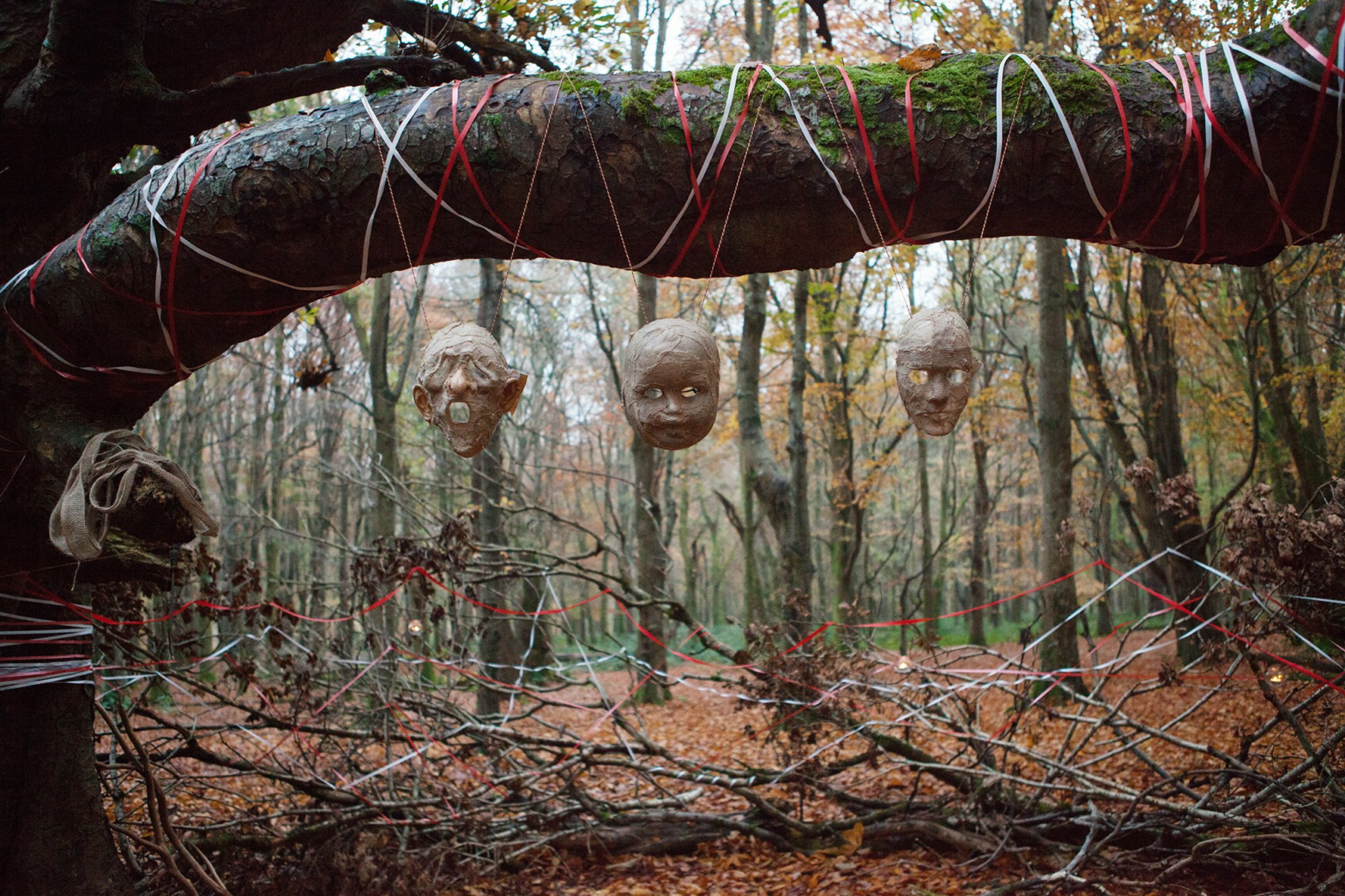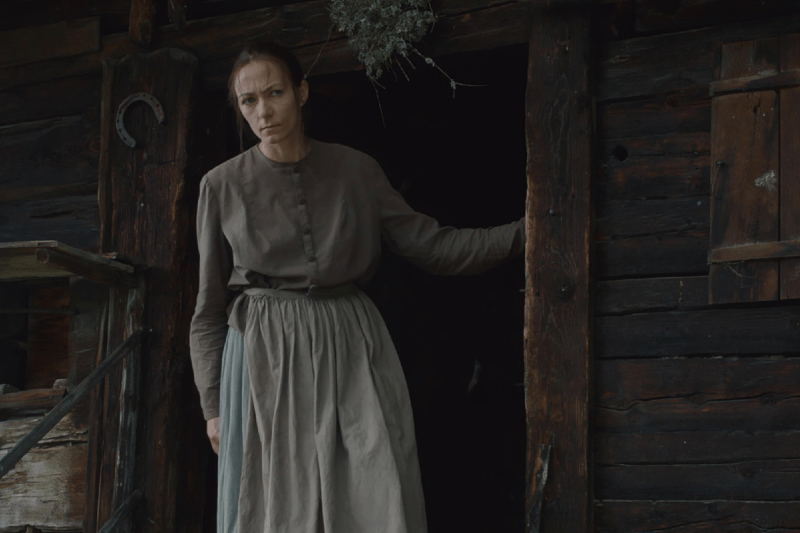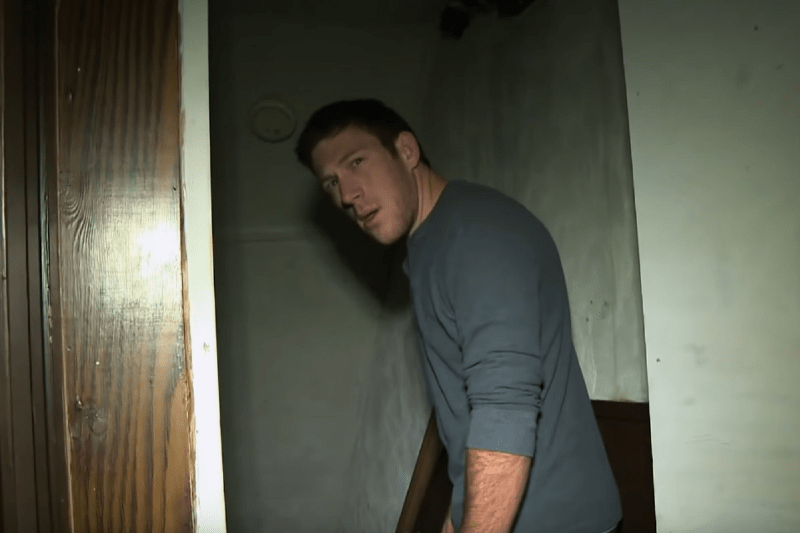Editorials
Changing Horror’s Sexual Paradigm in ‘Crone Wood’
March 25th, 2021 | By Mary Beth McAndrews

Something about a handheld camera makes men horny. You see it throughout found footage horror, from Paranormal Activity to V/H/S. DIY footage always seems to come with the man trying to coerce his wife or girlfriend to make a sex tape. Micah in Paranormal Activity asks his girlfriend Katie on multiple occasions if they can do some extracurricular activity in front of his new recording device meant to capture demonic activity. In the segment of V/H/S “Amateur Night”, three drunk men try to film their sexual exploits. There is a male-centric fascination with recording sex and the possibility of having a physical reminder of that sex.
But in the 2016 Irish found footage film Crone Wood, director Mark Sheridan wants to subvert those expectations by showing shifting gazes between men and women. Danny (Ed Murphy) and Hailey (Elva Trill) have just met and are having an amazing first date. Danny is recording this magical experience for posterity, a beautiful memory if he never sees her again. Sparks fly and they decide they want to keep the day going with a camping trip into the local woods. They go shopping, buy the gear, and head off on a trek through the gorgeous Irish greenery.
When night falls, sex comes to the front of their minds. Now, at first, Crone Wood does follow that path of a man hiding a camera to film a sexual encounter. Hailey discovers her companion’s intentions and is understandably enraged. Yet, Danny tries to play it off like she should pity him. He tells her that this footage would be evidence that he was able to have sex with such an attractive woman and to take it as a compliment. He has violated her consent, and yet places responsibility square on her shoulders. This scene sets up the expected sexual dynamic of the film’s characters, placing the man and woman at odds over sex and laying the base for resentment.
Then, this narrative quickly flips as the camera changes hands and, by extension, perspective. The couple wanders into the ruins of an old building, making sure no one is stalking them in the middle of the night. Here, Hailey begins to willingly take her clothes off in front of the lens and expresses her explicit consent to being filmed. This is a rare instance in found footage where recorded sexual propositions are met with enthusiastic approval from both parties. While this comes after Danny’s manipulation, in this new scenario Hailey is taking control by making the first move. She then takes the camera from Danny and begins filming—Danny’s body is now being objectified.
The very obvious male gaze is challenged as Hailey—playing cinematographer—tells Danny to strip for her. She zooms in on his hands unbuttoning his jeans and the outline of his penis just under his cotton boxer briefs. It’s a jarring shift as it disrupts those expectations of how female and male-coded bodies are viewed onscreen, particularly in the found footage subgenre. Sheridan makes this shift rather obvious, and while it may just seem like a playful action between lovers, it teases how much further this sexual paradigm is about to be shifted.
When a man in a mask disrupts this sexual encounter, they realize that something strange is going on in these woods. They eventually run across a house that serves as a refuge for young women, led by a kindly older woman. But, nothing is what it seems, and it is revealed this is a coven of witches searching for a virile young man to father a child for them. Even more, Hailey is a member of this coven and had these sinister designs since she met Danny. She has been the predator, seeking out her prey that will serve a specific purpose then be discarded.
As soon as this is revealed, the gaze again shifts from male to female as a young woman now films their rituals, capturing everything for historical record. Women are often the objects of torture in found footage, as male camera operators and their posse torture and assault her as spectacle. But here, women are the villains and Danny is rendered vulnerable both by the coven and the screen.
Then, Crone Wood does something even more unusual: Danny is raped by two women on camera. Sexual assault in genre filmmaking as a whole is almost exclusively enacted on the female body as they’re ravaged and ruined by a group of strange men. Male sexual assault is albeit ignored, therefore alienating an entire group of people who can also experience that violence. Here, Danny is drugged and tied down on a table while Hailey forces him to impregnate her. He groggily protests, and she shushes him. The male body is rendered helpless as it is taken advantage of by a woman in a place of power due to her secret knowledge. Earlier, Danny said he was lucky to have the chance to have sex with such a stunningly beautiful woman and wanted proof. Now, he has that proof but not in the way he had planned. Sheridan turns that desire on its head and creates a complex story that flips gender expectations to create a film with a message about sexual dynamics in horror.
Danny’s rape is filmed by a woman, which adds a fascinating layer to the harrowing scene. At first, while he is being “prepped”—forced into an erection—by another woman, the camera operator is filming in closeup, focusing on his pained face and then the smiling faces of witches watching the ceremony (a set of spectators with which we are meant to identify). They’re excited to be taking advantage of such a strong man and perhaps we feel that same joy. But, what does that joy mean? Why would watching the rape of man not be as harrowing as that of a woman? With Crone Wood, Sheridan is asking those questions, placing the spectator in a deeply uncomfortable position to acknowledge how sexual violence is typically represented on screen.
When Hailey has sex with Danny and the true ritual begins, the shots change from close-ups to viewing the assault from a distance. The camera operator is being blocked from approaching by a circle of women who are facing away from the ritual, but with the same smiles on their faces. Instead of focusing on the pain of Danny’s face and the devilish joy of those involved in his preparation, the viewer is only shown Hailey’s back, establishing a dichotomy between assault as spectacle versus serving a perverse purpose, as if this can be justified by the characters within the film. As Danny ejaculates—something that is possible without his consent—he has been forced to impregnate Hailey and in turn becomes the male version of a vessel. Women are often seen as the vessel to receive the seed of an evil force, but here the man becomes an unwilling source whose seed is harvested as if it is a valuable natural resource.
Sexual assault is never easy to watch, but it’s important to carefully represent the reality of such violence on screen. The stigma around men being assaulted is harmful and further perpetuates ideas of toxic masculinity. In Crone Wood’s shifting perspectives from the male gaze to a sinister female gaze, sexuality in found footage—and horror in general—is interrogated as more than the tortured female body. Crone Wood works to rewrite the phallocentric narratives often seen in the horror genre to provide a crucial perspective on sexual violence against men.
Visit our Editorials page for more articles like this. Ready to support more original horror criticism? Join the Certified Forgotten Patreon community today.



